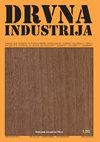Kemijski sastav i antimikrobno djelovanje eteričnih ulja dobivenih iz dijelova biljke Juniperus excelsa M. Bieb.
IF 0.8
4区 农林科学
Q4 MATERIALS SCIENCE, PAPER & WOOD
引用次数: 0
Abstract
This study was conducted to determine the chemical content, antibacterial, and antifungal properties of essential oil obtained from the parts of the plant called Juniperus excelsa M. Bieb. In this study, essential oils of cone, needle, and twig of J. excelsa plant, which is a naturally grown plant in Gümüşhane province, were obtained by hydrodistillation method in a Clevenger type device. Chemical composition of essential oils was determined thanks to the analysis conducted with GC-MS/FID device. Besides, antimicrobial activity tests of essential oils were decided in contrast to 23 different microorganisms with the disc diffusion method. As a result of the essential oil analysis of J. excelsa, the percentage of essential oil yield in cones, needles, and twigs was found as 5.88 %, 2.00 %, and 0.62 %, respectively. α-pinene was confirmed to be the most abundant main compound found in the essential oils of cones, needles, and twigs. As a result of the essential oil analysis of the cone, needle, and twig of J. excelsa species, it was revealed that monoterpenes were the most abundant chemical class in terms of percentage. In the antimicrobial activity test performed on the essential oils of J. excelsa plant parts, it was found that cones, needles, and twigs have a strong antimicrobial effect against Bacillus subtilis, Enterococcus faecalis, Escherichia coli, Escherichia coli O157:H7, Listeria monocytogenes, Salmonella enteritidis, Salmonella typhimurium, Staphylococcus aureus, Candida albicans, Penicillum expansum, Saccharomyces cerevisiae bacteria, yeast, and molds.杜松精油的化学成分和抗菌作用
这项研究是为了确定从一种叫做Juniperus excelsa M. Bieb的植物中提取的精油的化学成分、抗菌和抗真菌特性。本研究在Clevenger型装置中采用加氢蒸馏法提取了青海地区天然生长植物黄连叶(J. excelsa)的球茎、针叶和枝叶的精油。采用气相色谱-质谱联用FID装置测定精油的化学成分。此外,用圆盘扩散法测定了精油对23种不同微生物的抑菌活性。通过挥发油含量分析,发现金丝桃球果挥发油含量为5.88%,针叶挥发油含量为2.00%,细枝挥发油含量为0.62%。-蒎烯被证实是在球果、针叶和树枝的精油中发现的最丰富的主要化合物。结果表明,单萜烯类化合物含量最高,其成分含量最高。对金丝桃植物部位精油进行抑菌活性试验,发现球果、针叶、细枝对枯草芽孢杆菌、粪肠球菌、大肠杆菌、大肠杆菌O157:H7、单核增生李斯特菌、肠炎沙门氏菌、鼠伤寒沙门氏菌、金黄色葡萄球菌、白色念珠菌、扩张青霉、酿酒酵母菌、酵母、霉菌均有较强的抑菌作用。
本文章由计算机程序翻译,如有差异,请以英文原文为准。
求助全文
约1分钟内获得全文
求助全文
来源期刊

Drvna Industrija
MATERIALS SCIENCE, PAPER & WOOD-
CiteScore
1.80
自引率
9.10%
发文量
32
审稿时长
>12 weeks
期刊介绍:
"Drvna industrija" ("Wood Industry") journal publishes original scientific and review papers, short notes, professional papers, conference papers, reports, professional information, bibliographical and survey articles and general notes relating to the forestry exploitation, biology, chemistry, physics and technology of wood, pulp and paper and wood components, including production, management and marketing aspects in the woodworking industry.
 求助内容:
求助内容: 应助结果提醒方式:
应助结果提醒方式:


